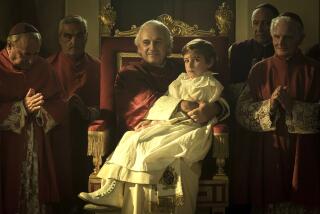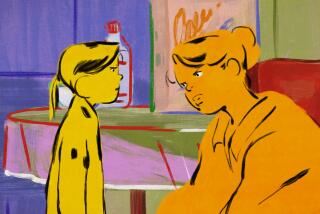MOVIE REVIEW : Food, Families Make ‘Story’ a Sumptuous Cinematic Feast
- Share via
Pupi Avati’s wonderful “The Story of Boys and Girls” (Laemmle’s Royal) is a comic-lyrical ensemble piece about two very dissimilar Italian families about to be uneasily united for a nuptial celebration. One family, from Bologna, is urban, rich, aristocratic and elitist. The other, residents of the rural area of Emilia-Romagna, are farmers--a huge raffish brood who squabble constantly and eat, drink and love with a sometimes Rabelaisian openness and glee.
The fact the families wind up at table together is a sign that the couple-to-be, Angelo and Silvia, are flouting conventions. Indeed they are. It is 1936, the peak of power for Mussolini’s Fascisti, and signs of social rigidity and tension are everywhere. Here, however, the lavish banquet prepared by Silvia’s family--one of the most sumptuous in a movie since “Babette’s Feast”--simply disintegrates in a stew of recriminations, discreet sexual signals, merriment, feuds and even gunshots.
That the feast survives at all is a testament to the power of ritual and convention. The dinner winds to its melodious end simply because everyone wills it to. And, though the rapprochement may be an artificial one, it survives even a near-rape and the revelation that one of the few outsiders is both adulterous and dying (Felice Andreasi).
“The Story of Boys and Girls” is a truly marvelous family story--exactly the kind of film moviegoers say they can’t find anymore: full of emotion, characters, comedy, pathos and lovingly re-created sights and sounds. And it gains an added measure of poignancy and resonance if we realize that Avati is actually telling the story of his own parents, imagining the cross-cultural circumstances that resulted in his birth.
Avati does not bathe his memoir in sentimentality. “The Story of Boys and Girls” is all the more delightful because there’s something astringent and a little unsparing in these pre-memories. Like Eugene O’Neill, Avati chooses to love his family--or families--not for what he wants them to be, but for what they are.
Though he’s been directing since 1968, winning many international awards, Avati is virtually unknown in America: more proof of the scandalous state of foreign film distribution here. Avati’s approach recalls both neo-realism and a cooler French naturalism, and, as if in homage to all these sources, the print of “The Story of Boys and Girls” that played at AFIFEST recently was in black-and- white. Since then, Avati has restored the original color; the muted, lovely, discreet palette of cinematographer Pasquale Rachini makes the scenes even more vibrant.
Avati has said that he didn’t try to shape or force “The Story of Boys and Girls” (Times-rated Mature for brief sexuality)--and we get a sense, for all its complexity, that it’s true. This story and these people, simply blew through him like a wind: stirring the land, drinking in the sun, leaving laughter and tears shivering in its wake.
‘The Story of Boys and Girls’
Davide Bechini: Angelo
Lucrezia Lante della Rovere: Silvia
Felice Andreasi: Domenico
Angiola Baggi: Maria
Massimo Bonetti: Baldo
An Aries Film release. Director-screenplay Pupi Avati. Producer Antonio Avati. Cinematographer Pasquale Rachini. Editor Amedeo Salfa. Costumes Graziella Virgili. Music Riz Ortolani. Production design Daria Ganassini, Giovanna Zighetti. Sound Raffaele De Luca. Running time: 1 hour, 32 minutes.
Times-rated: Mature (sexual situations and themes).
More to Read
Only good movies
Get the Indie Focus newsletter, Mark Olsen's weekly guide to the world of cinema.
You may occasionally receive promotional content from the Los Angeles Times.








